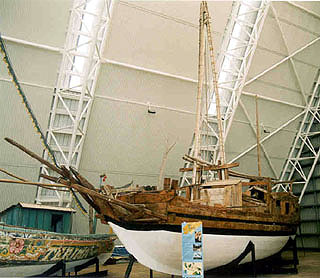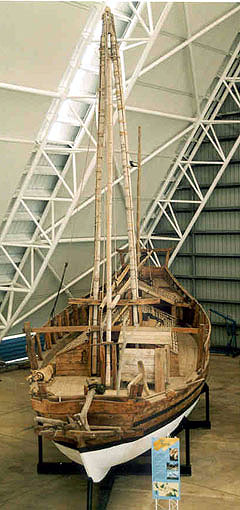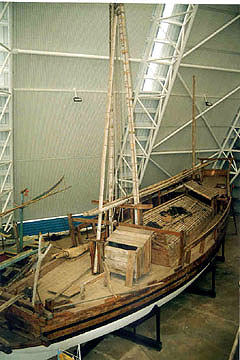|
Hati Marege,
meaning "Heart of Arnhem Land" is a replica of a typical
19th century Makassan perahu padewakang.

It was built traditionally
without any metal fastenings by the Kanjo boatbuilders
of Tana Baru on the southeastern part of Sulawesi, Indonesia
for the Australian Bicentennial celebrations in 1988, and
was sailed to Darwin by a crew of 13.

|
|

Hull
dimensions
|
Length
|
14.25 metres |
|
Depth
|
1.43 metres |
|
Beam
|
4.28 metres |
|
Other interesting
stuff (botanical names are italicised, macassarese
names are bolded);
It has 12 main
ribs, kilu, and a navel, poci. Is fitted with
twin rudders, guling, which are made from Intsia
bijuga, kayu bayang. The tilled rectangular mainsail,
sombala tanja is supported by a bamboo tripod mast,
palajarina. The bilge pump is also constructed of bamboo!.
The wooden anchor, balangu*
is weighted with stone. On deck you can see the wooden fire
box, dapur, used for cooking.
The keel, kalebiseang,
is Borneo ironwood, Eusideroxylon zwageri called kayo
bado or kayo sappu. Vitex gofassus, kayu
kantondeng, or V. pubescens, kayu nanasa
form the hull planks below the waterline, the stern, sternpost
and lower top sides of the hull. Teak, Tectona grandis,
kayu jati (which naturally occurs from India to Laos
was introduced to Indonesia 400-600 yrs ago where it is now
naturalised) and Calophyllum inophyllum, Borneo mahaogany
or beauty leaf, kayu pude form the upper hull planking
and deck beams.
Rigging is rattan,
coir fibre, hemp fibre and Arenga pinnata (a palm,
also used in alcohol manufacture) fibre (ijok).
The waterproof
cabin is coconut thatch and bamboo.
*
This macassarese word is also used by yolngu. Similarly, the
yolngu words, dhomala (sail) and goli (rudder)
are macassarese in origin; sombala and guling
respectively.

|

